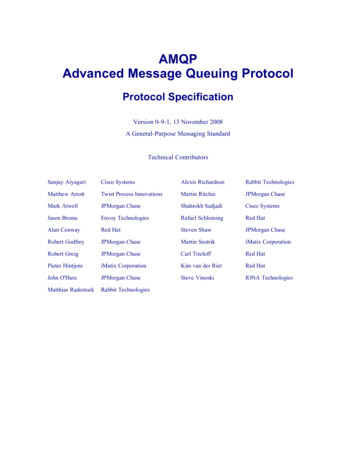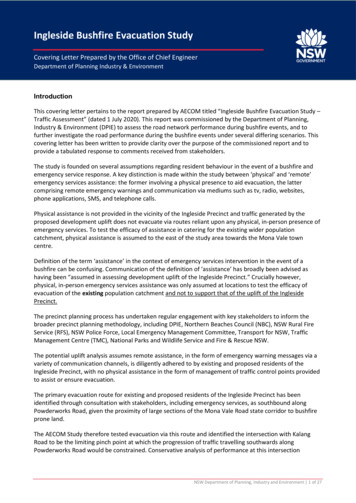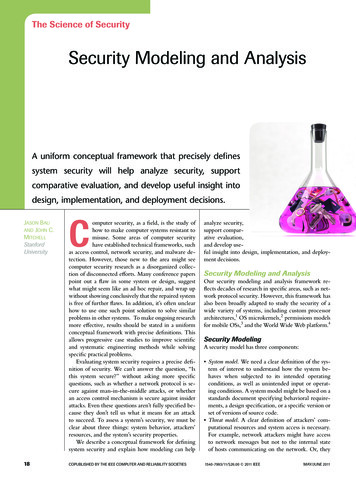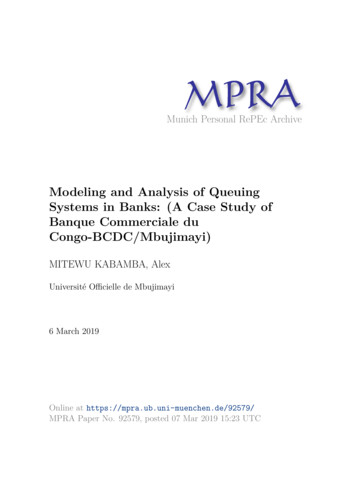
Transcription
Munich Personal RePEc ArchiveModeling and Analysis of QueuingSystems in Banks: (A Case Study ofBanque Commerciale duCongo-BCDC/Mbujimayi)MITEWU KABAMBA, AlexUniversité Officielle de Mbujimayi6 March 2019Online at https://mpra.ub.uni-muenchen.de/92579/MPRA Paper No. 92579, posted 07 Mar 2019 15:23 UTC
Modeling and Analysis of Queuing Systems in Banks:(A Case Study of Banque Commerciale du CongoBCDC/Mbujimayi)Alex Mitewu KabambaDepartment of Industrial Economics/Faculty of Economics and Management/Université Officielle de Mbujimayi/Mbujimayi city/Democratic Republic of Congo.alexmitewu@gmail.comABSTRACTThis study examined the application of queue theory in the banking system inDemocratic Republic of Congo, with particular reference to BCDC (BanqueCommerciale du Congo)/Mbujimayi. The queuing characteristics of the bank wereanalyzed using a Multi-Server Queuing Model.The obvious implication of customers waiting in long and winding queues couldresult to prolonged discomfort and economic cost to them; however increasing theservice rate will require additional number of tellers which implies extra cost tomanagement. Data for this study was collected at BCDC bank for one weekthrough observations and was formulated as multi-server single line queuing model.The data was analyzed using TORA optimization Software as recommendedsoftware for operational research. The performance measures of different queuingsystems were evaluated and analyzed. The results of the analysis showed using asix-teller system was better than a five in terms of average waiting time.KEYWORDS: Queue theory, Banking System, Multi-Server Queuing Model,Economic cost, Service rate.1. INTRODUCTIONa. Study contextCurrent globalization is characterized by intense and growing competition that doesnot exclude the banking industry. Managers continue to face tough challenges tothe survival of their businesses.As commercial banks are a major component of the financial system, anintermediary between the surplus and deficit sectors of the economy, they are stillthe center of attraction of many customers who want to carry out one or the othertransaction through the services provided by them.Banks in the city of Mbujimayi are generally characterized by congestion; this oftenleads to a low level of customer satisfaction and encourages customer movementsfrom one bank to another, in search of the services provided without much delay.According to (CHRISTOPHER M & D., 1997), the survival of organizations dependson their ability to get closer to their clients and to understand the needs anddesires of the client. For a business to succeed, it must focus on meeting the needsof customers by organizing itself to respond to them and target customers moreeffectively.1
For many years, the subject of customer satisfaction has been on the agenda ofmany organizations, so satisfaction has become a crucial element and a concern forcustomers and organizations. Banks are among the organizations for whichcustomer satisfaction is the key factor for success and a major source ofcompetitiveness.Contact systems should take a close look at the theory and psychology of queues totake advantage of client participation to avoid the negative effects of delays andother psychological factors on the quality of service. A key determinant of customersatisfaction is ease of access, which includes the location of the service facility, itshours of operation, and its minimum wait time to receive service.Waiting times are the main source of dissatisfaction. Indeed, since the customerenters a system to receive a service, and leaves the premises after being served, it isimportant to address the problem of queues.The lack of professional resources can be the cause or the source of dissatisfactionfelt by the customers; this feeling gives them the impression of being poorly servedand creates a feeling of discomfort or even insecurity at home, which can harm thequality of the service.To help decision-makers make optimal decisions, mathematical models are appliedto find a solution to organizational problems and to optimize economic techniques.The queuing theory is thus among those mathematical models that analyze anddeal with the organizational difficulties faced by organizations with files to manageand organize.b. Objectives of the researchMore specifically, the objectives of this study are: Build a clear idea about the use of one of the quantitative methods ofoperational research that is the theory of queues, in support of managers tomake their decisions. Identify the need for commercial banks in the DRC in general, andcommercial banks in Mbujimayi in particular, to use queuing theory inorganizing the queues of their wickets; Apply empirically the model of multi-channel queues with exponentialPoisson arrivals and service times (M / M / S), in the context of theMbujimayi banks.2. EMPIRICAL LITERATURE(GRACE, 2012), basing his research on: "Waiting lines management and customersatisfaction in Banks in Kenya".The main objective of this research was to determine the extent to which queuemanagement affected client satisfaction in Kenya banks.To achieve the main objective, the study determined the effect of queuemanagement on customer satisfaction, how commercial banks manage the queues2
and the challenges they face in queue management. The search consisted of acensus of all 43 commercial banks registered in Kenya.The study concludes that the majority of commercial banks in Kenya are notsatisfied with queuing management. The main ones are the cases where thecustomers are dissatisfied, it is the perceived expectation. In addition, bankcustomers are satisfied with the information provided in the waiting room and thewaiting environment within the bank. Clients are not satisfied with managementmeasures such as the use of physical barriers, automated queuing systems, onlinebanking, Internet banking, mobile banking and agencies banking.(FARAYIBI, 2016), is conducting his study under the theme: "Investigating theApplication of Queue Theory in the Nigerian Banking System".The author examined the application of queuing theory in the Nigerian bankingsystem, with particular reference to GTBank and the Ecobank Idumota branch inLagos, Lagos State.Queued bank characteristics were analyzed using a multiserver model. Theanalysis of performance measures, including bank standby and operating costs,was done to determine the optimal level of service.At the end of its analyzes, the results revealed that traffic intensity was higher inGTBank with P 0.98 than in Ecobank with P 0.78. In addition, the potential useshowed that Ecobank was well below efficiency compared to GTBank. Looking atthe waiting time of online customers and the time spent in the system, that is (Wq W), he discovered that Ecobank's customers spent more time before being servedboth in the queue and in the system as those of the bank GTBank.The study concluded by highlighting the relevance of the queue theory for theefficient delivery of banking sector services in Nigeria.(YUSUF, BLESSING, & KAZEEM, 2015), base their studies on: "Queuing Theoryand Customer Satisfaction: A Review of Performance, Trends and Application inBanking Practice (A Study of First Plc Gwagwalada, Abuja Branch)".The main objective of this study is to examine how queue theory has been used toprovide satisfactory service to customers.The study revealed that most bank customers are not satisfied with the queue theyare experiencing and that the study advocated the effective and efficient applicationof the queue theory, this can be particularly advantageous for banks with highexchange rates.3. METHODOLOGICAL FRAMEWORK1. Description of the queuing theoryKendall's notation makes it possible to summarily designate a waiting girl system:A / S / P / K / D, its terms are as follows (F.A, 2014):3
A: the law of inter-arrivals or the arrival process.S: the law of service.P: the number of servers.K: the capacity of the system that is the room.D: the discipline or service policy, that is, how and in what order clients are served.Waiting discipline is the priority rule determining the order in which clients willaccess the resource modeled by the server. The standard waiting disciplines, aswell as their acronyms, are:FIFO: first in first out "first come, first served" is the service discipline used mostoften and it will be accepted by default.So the characteristics of the queuing theory are:-The average customer arrival rate (λ) follows the Poisson distribution.The average service rate (μ) follows the exponential distribution.λ μ.Service discipline is based on FCFS (first come first served).Since it is necessary to define the parameters of the queuing theory:-n: represents the number of individuals in the system (in the queue and inthe service)P represents the probability of n individuals in the system (BOUGUERRA,2007).4. METHOD OF DATA COLLECTIONBasically, the data used for this study were obtained from primary sources. Themethod of data collection is through direct observation. A wrist watch, a pen and anotepad were requirements needed for the recording of relevant information suchas; number of customers the arrival times of customers, waiting time, and servicetime. The observation was made during the working hours (8am – 4pm). Therecorded information was used to calculate average waiting time, average servicetime and the utilization factor.5. METHOD OF ANALYSISThe method of analysis for this study is the multi-server queuing modeling systemwhich follows (M/M/K): ( /FCFS) specification. In the case, the performancemeasure analysis including, the arrival time, waiting time service time, priority level,for average customers and the number of servers available were computed usingthe appropriate tools. Secondly, the graphical representation of the generatedperformance measure values was done.4
1. Queuing model notation:𝜆 Mean arrival rate𝜇 Mean service rate𝑘 Number of service channels𝑛 Number of customers𝐿𝑠 Average number of customers in the system (waiting or being served)𝐿𝑞 Average number of customers waiting in the queue𝑊𝑠 Average time customers spend in the system𝑊𝑞 Average time customers wait in the queue𝜌 System utilization𝑃0: The probability that there are zero customers in the system𝑃𝑤:The probability that a customer has to wait𝑃𝑛: The probability that there are n customers in the system2. Multiple-Server Queuing Model with Poisson Arrivals and ExponentialService Times (𝐌/𝐌/𝐤)The model adopted in this paper is multiple channel queuing system, in which twoor more servers or channels are available to handle arriving customers. Let stillassume that customers waiting service form one single line and then proceed to thefirst available server. For this queuing system, it is assumed that the arrivals followa Poisson probability distribution with rate λ. Each of these channels has an1independent and identical exponential time distribution with meanμ.Equations for Multi-channel queuing Model:Utilization factor𝑝 λ𝑘μ(1)The probability that there are zero customers in the system:𝑘 11 λ 𝑘 1 λ 𝑘 𝑘𝜇𝑃𝑜 [ ( ) ( )]𝑛 𝜇 𝑘𝜇 λ𝑛 𝑛! 1𝑛 0(2)The probability that there are n number of customers in the system:𝑃𝑛 {𝑃𝑛( 𝑛! ) 𝑃𝑜, 𝑖𝑓 𝑛 𝑘𝑃𝑛(𝑘!𝑘 𝑛 𝑘 ) 𝑃𝑜, 𝑖𝑓 𝑛 𝑘(3)5
Probability that a customer has to wait:1λ 𝑘 𝑘𝜇𝑃𝑜𝑘𝜇 λ𝑃𝑤 𝑘! (𝜇)(4)The average number of customers in the system:λμ(λ 𝜇)𝑘λ𝐿𝑠 (𝑘 1)!(𝑘𝜇 1)2 𝑃𝑜 𝜇 (5)The average number of customers in the queue:λμ(λ 𝜇)𝑘𝐿𝑞 (𝑘 1)!(𝑘𝜇 1)2 𝑃𝑜 Or 𝐿𝑞 𝐿𝑠 𝑝 (6)The average time a customer spends in the system:λμ(λ 𝜇)𝑘1𝑊𝑠 (𝑘 1)!(𝑘𝜇 1)2 𝑃𝑜 𝜇The average time a customer spends in the queue:μ(λ 𝜇)𝑘𝐿𝑠λ(7)1𝑊𝑞 (𝑘 1)!(𝑘𝜇 1)2 𝑃𝑜 Or 𝑊𝑞 𝑊𝑠 𝜇 3. Economic Analysis of Queuing Systems𝐿𝑞λ(8)Queuing models can be used to determine operating performance of a queuingsystem. In economic analysis of queuing systems, we seek to use the informationprovided by the queuing model to develop a cost model for the queuing systemsunder study. The two basic types of costs associated with queuing systems are thecosts involved in operating each service facility like the costs for equipment(including maintenance), materials, labor, etc. these cost increases as the numberof service facilities put into operation increases and the opportunity costsassociated with causing customers to wait in the system. As the number of servicefacilities in operation increases, the time the customer has to wait in the system,on the average, decreases, hence the cost associated. The two types of cost are inconflict because an increase in one automatically causes a reduction in the other orvice versa. The total of these two basic types of costs goes to a minimum at somespecific number of facilities. This then is the optimum number of service facilitieswhich should be operated by the manager- optimum because it minimizes the totalcost of both operating the service facilities and waiting time in the system. The totalcost model includes the cost of waiting and the cost of service:Where:𝑇𝐶 𝐶𝑤𝐿𝑠 𝐶𝑠𝑘Cw the waiting cost per time period for each customerLs average number of customers in the system6
Cs the service cost per time period for each channelk the number of channelsTC the total economic cost per time periodCostsFigure 1Total costService costWaiting cost0Optimal level of service6. RESULTS AND DISCUSSIONThe multiple channel queuing system at Banque Commerciale du Congo with meanarrival rate (λ) 70 customers/hr., service rate (μ) 20 customers/hr. and withnumber of Tellers (k) 5 has been solved using TORA optimization software toevaluate the measures of performance of the queuing system at the bank resultswere obtained as shown in Table 1.Table 1. Summary of Analysis of Multiple-Server Queuing Model at BanqueCommerciale du Congo (BCDC)Performance measure5 Tellers6 TellersArrival rate (𝛌)Service rate (µ)System Utilization (𝝆)LsLqWs (hours)Wq 8%702058.333%3.7480.2480.0540.0042.896%17.74%7
From the queue performance measures, increasing the number of teller points to 6from the table 1 show a decrease in the waiting time in the queue and systemwould reduce to 0.004 hours and 0.054 hours respectively as against the presentsituation where each customer has to in the queue and system for 0.013 and 0.063hours respectively. As a result each teller will be busy 58.33% that is 41.67% of thetime it is idle.The waiting situation should normally be as defined in the table above. It washowever noted during the period under study that, due to the non respect of thediscipline of the file and the slowness in the chief of the waiters, a customer waitmore than 45 minutes before being service and the time spent in the systemfluctuates around one hour; which represents a very long duration of waiting andcreates dissatisfaction in the bank customer's lead.Already we observe that the rate of service is largely very low compared to thearrival rate is 20 customers 70 customers / hour. This will inevitably createenthusiasm in front of the bank and reinforces the discontent of the customers interms of the opportunity costs they face waiting too long.7. CONCLUSION AND SUGGESTIONSIn this study, we presented the concept of the banking system of BCDC/Mbujimayi(Banque Commerciale du Congo), as a multiple-channel queuing model with fisharrivals and exponential services. The analysis of the queuing systems showsincreasing the numbers of teller points up to 6 in the queue and system. This willalso increase the efficiency of the establishment and customer satisfaction. Basedon the summary of the analysis of different types of management, we recommendthe management should adopt a six-server model to reduce economic cost.Some managerial recommendations for managing queues within the BCDC: First, an application of queue theory within the BCDC is a necessity; Determine a tolerable wait time for clients and set goals based on what isacceptable; Try to entertain customers while waiting. Music, coffee, magazines, televisionare all sources of distraction that make customers wait; Inform clients of the length of the wait. This is particularly important whenthe wait is likely to be long. Explain to customers why the wait is abnormallylong, and what the manager is doing to fix it; Keep visible employees away from the service. There is nothing morefrustrating for a person waiting in line than to see an employee busy doingother things than coming to meet the waiting customers; Segment the customer. If a group of customers can be served quickly, createa special queue to keep them waiting longer than necessary; Create a wicket on university sites to facilitate the payment of academic feesby students; Train and sensitize staff to kindness. In addition to the daily smile and thewarm, even personalized welcome, the staff must be able to face difficult8
situations and react in such a way as to relax the atmosphere whencustomers become impatient;Encourage guests to come during dead times. Inform customers about lessbusy periods. The manager of a Saint-Laurent city bank branch suggestedthat his older clients come on Wednesday, the least busy day, so that hecould devote more time to them;Have a long-term vision regarding the management of waiting. Put in place aprocess of continuous;improvement to reduce waiting times;Think about ways to speed up the process of treating customers. Automatewhen possible without eliminating custom contact. We always need a littleattention.REFERENCESBOUGUERRA, R. (2007). Détermination du niveau d’utilisation des modèles desfiles d’attente comme l’un des méthodes quantitatives dans l’administration, étudede l’hôpital Zahraoui à M’sila. revue des sciences économiqes et sciences de lagestion, N 7.CHRISTOPHER M, P. A., & D., D. (1997). Bringing Quality, Customer service andMarketing together. Relationship Marketing. Batter Worth: Heinemann.F.A, M. (2014). Appliquer le ToC Lean Six Sigma dans les services: Déployer et mettreen oeuvre les méthodes et outils d’une relation de service performante et durable.Paris: Lexitis éditions.FARAYIBI, A. (2016). Investigating the Application of Queue Theory in the NigerianBanking System. Munich Personal RePEC Archive , 1-14.GRACE, W. K. (2012). Waiting lines management and customer satisfaction incommercial banks in Kenya. University of Naîrobie .YUSUF, M. O., BLESSING, N., & KAZEEM, A. O. (2015). Queuing Theory andCustomer Satisfaction : A Review of Performance, Trends and Application inBanking Practice (A Study of First Plc Gwagwalada, Abuja Branch). EuropeanJournal of Business and Management, Vol.7, No.35 , 90-96.KATZ, K. L., B. M. LARSON et R. C. LARSON (1991). Prescriptions for the Waitingin-Line Blues : Entertain, Enlighten and Engage. Sloan Management Review, vol.32, n 2.Taylor, S. (1995). The effects of filled waiting time and service provider control overthe delay on evaluations of service. Journal of Academic Marketing Science, endall- Notation.html.9
Stirling, E. T. (2001). Queue theory and applications in health care- .nets.nihr.ac.uk/ data/assets/pdf file/0003/./FR-08-1204-029.pdf10
GTBank with P 0.98 than in Ecobank with P 0.78. In addition, the potential use showed that Ecobank was well below efficiency compared to GTBank. Looking at the waiting time of online customers and the time spent in the system, that is (Wq W), he discovered that Ecobank's customers spent more time before being served



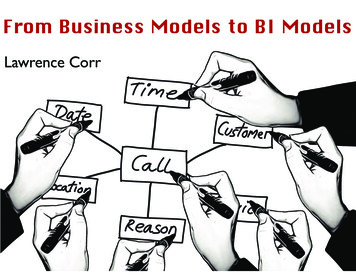
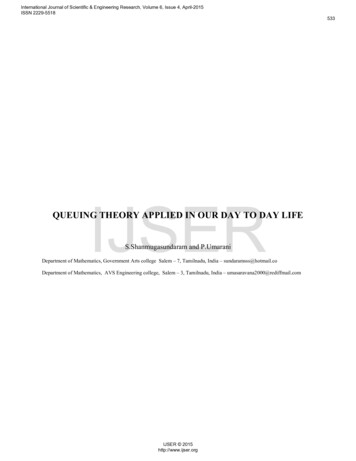

![[MS-MQMR]: Message Queuing (MSMQ): Queue Manager Management . - Microsoft](/img/49/5bms-mqmr-5d-160714.jpg)
